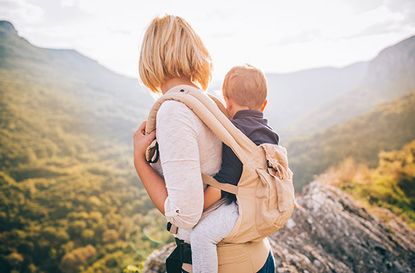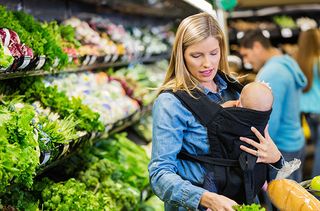Babywearing: How to carry your baby safely
Babywearing can free up your hands and make life a lot easier!


Babywearing is a term that refers to carrying your baby by strapping them to your body in a baby carrier, and actually wearing them on yourself.
This method has been used for hundreds of years, and now there's some great new methods and products available that you can use to make carrying your baby around as comfortable and practicable as possible.
Babywearing can be a little tricky to start off with as there are different kinds of baby carriers to try out and some may not work for you. But, once you've got your head around a type that suits you, it can be a great option.
You can start using a babywearer or baby carrier from birth. There are certain types of babywearers that suit newborns better such as slings. You can wear your babywearer all day everyday if you want to, but there's usually a weight guideline so you know what age to stop.
Benefits of babywearing

Convenience
The biggest positive of babywearing is that it's a really convenient way of carrying your baby around with you. If you have your little one strapped to your torso it leaves your hands free to do one of the 10 million things you need to be juggling in a day.
Breastfeeding
Babywearing works well for breastfeeding mums, as carrying your baby to your chest helps you to gain a stronger bond and understanding of their feeding patterns and hints that they're hungry. If you're able to sense that they're hungry before they become disturbed, not only can you feed them much easier with them strapped to your chest but you can keep them happy before they start crying.
Bonding
Holding your baby close to your chest all day is special bonding time between you. In this time your baby will be taking in your scent, breathing patterns, body temperature and heart beat, and even regulate theirs to match yours.
GoodtoKnow Newsletter
Parenting advice, hot topics, best buys and family finance tips delivered straight to your inbox.
We spoke to childbirth education guru Katharine Graves, founder of KG Hypnobirthing, who believes that babywearing is a positive thing for a parent to do for this reason. She encourages mothers to wear their babies from birth in her parenting classes where she works with lots of new families.
Katherine said, 'In our teacher training and parenting classes, we always encourage women to wear their babies from birth - it relates to what is known as the fourth trimester. It promotes bonding and oxytocin boost, calms your baby and give you two hands to get on with what you need! They are invaluable!'
'Skin to skin bonding boosts the hormone oxytocin which is important as babies have spent nine months growing in the womb. Oxytocin is known as the cuddle hormone and it promotes bonding. This is why it's good for dads too because they get to experience the bonding hormone too.'
Types of baby carriers

Slings
A sling version of a baby carrier contains a large piece of swathed material that drapes over your shoulder and across your torso. These work particularly well for newborn babies as a sling offers the right amount of support to lean them on your chest where they can snuggle into the material.
Wraps
A wrap babywearer ties around your torso and up over both of your shoulders creating a comfy and sturdy seat for your baby to sit in. Wraps are pretty versatile and work well for toddlers.
Soft structured carriers
A soft structured carrier is a more sturdy, seat-like babywearer which may have buckles and two thick straps. These structured carriers are your best friends when you're carrying your baby all day or doing an outdoors activity like a long walk or hike.
More: The best baby carriers
Babywearer safety guidelines

Babywearers are a very safe way to carry your baby and each one will have specific instructions to ensure you are using it properly. However, there are a few main safety guidelines to make note of and tick off in your head when you are carrying your baby:
Ensure your baby's airway is clear
Your baby's face shouldn't be buried or underneath the fabric they're being held in, if you have to move fabric out of their face to see them then they need more breathing room. The positioning of their face is also important, the chin should be tipped upwards not resting down on their chest. If their face is pressed against your chest, you must move your baby's face to the side so their ear is resting on your chest instead.
Keep your baby in an upright position
Avoid moving your baby around and leaning them to the side in your carrier as that's not the way the carriers are designed to hold a child. The exception to this rule is if you choose to breastfeed your baby in your carrier.
Always practise in a safe environment first
Obviously you want to ensure that you've practised how to use a babywearer before you use it with your little one, so take as many precautions at home as possible. First experiment with your babywearer using a doll or toy, before trying it with your child over a bed or sofa.
Check your baby's leg position
When your baby is sitting with the babywearer you want to ensure that their knees are higher than their bottom and legs are spread widely so that hips and spine are supported. Make sure that their legs are not dangling down so that their hips are pulling with the weight of their legs.
Be careful of your back
Different shaped carriers will suit different people, but make sure your carrier isn't putting pressure on your back or spine in a negative way.
Katherine says, 'Some popular carriers can place strain upon a mums back due to the positioning of the baby and in extreme cases this can cause hip alignment issues. Brilliant brands such as Kari Me, Moby and Ring Sling (non structured wraps) are ideal from birth and for those who prefer structure, the Ergo is a brilliant bet and for newborns, simply pop in a newborn insert. You may also find it helpful to find a local sling library where you can pop along and try them on / rent / get advice before you purchase.'
Do you use a babywearer with your little one? How beneficial do you find it? Let us know in the comments below!
Trusted, informative, and empathetic – GoodToKnow is the ultimate online destination for mums. Established in 2007, our 15-year-strong archive of content includes more than 18,000 articles, 1,500 how-to videos, and 7,000 recipes.
-
 Compromising may be killing your relationship - here are 5 ways to reach healthy compromises, according to relationship expert
Compromising may be killing your relationship - here are 5 ways to reach healthy compromises, according to relationship expertCompromising isn't always the best way to keep the peace in a relationship
By Charlie Elizabeth Culverhouse Published
-
 Best interactive pets for kids: 15 gift ideas for children of all ages
Best interactive pets for kids: 15 gift ideas for children of all agesFrom puppies to axolotls, take a look at our selection of the best interactive pets you can buy that are sure to be a hit with little animal lovers
By Sarah Handley Published